FRIDAY'S SCRIPT TIP:
THAT'S SKETCHY!

George Bernard Shaw once said "The United States and Great Britain are two countries separated by a common language" and the word “sketchy” is a great example of that. In Great Britain “sketchy” means dishonorable or misrepresenting itself, but in the United States it means not enough information has been given. Some words are a bit sketchy - they are so vague that they can easily be misinterpreted. As writers we deal with the specific words and specific meanings, and lazy writing often uses words or sentences or characters or situations or even stories that are so vague they have no meaning. We don’t want to write generic stories about generic characters, we want our characters and stories to come alive on the page because they are flesh and blood - real. Not sketchy in either country’s version of the word.
Since this is Friday The 13th, I thought it would be fun to look at sketchy writing using the 2009 remake of FRIDAY THE 13th as an example.
For some strange reason in 2008-2009 I was a hot writer in Hollywood, meeting with a bunch of studios on projects and landing a job writing the remake of a hit 1980s horror flick... which resulted in my being invited to a bunch of red carpet premieres in Hollywood including the remake of FRIDAY THE 13th. So I saw the film before anyone else did, and went to the afterparty where I sat with Amanda Righetti, the movie’s incredibly beautiful star... and her boyfriend.
FRIDAY THE 13th (2009) was supposed to launch a new series of films, but ended only making $40 million off a $20 million budget, and when you factor in distribution costs (which average around $35 million) it was decided not to make any sequels. If you have been reading the trades, you know that the rights to the FRIDAY THE 13th franchise are tried up in the courts, because original screenwriter Victor Miller - who was probably paid peanuts for his script back in 1980 - has reclaimed the rights to the characters in court under a section of copyright law that allows creators to reclaim their creations after 35 years. It’s a wonderful mess of a case that may take forever to be resolved... and meanwhile, no Jason Vorhees movies since 2009.
JASON RETURNS?

The 2009 remake was just okay. Not really a remake, not a re-imagining, but kind of a sequel to the first film... using parts of the first 3 original films. It totally respected the first film (and its end twist) even though it has Jason alive instead of drowned. It’s totally a 1980s style horror movie, just with a much bigger budget. Boobs and blood and at least one cool kill at the pier. The rest are just okay kills (some recycled from the first 3 films), some okay suspense scenes, and some stuff swiped from SEE NO EVIL and HILLS HAVE EYES (remake) 2. We eventually even get the shh-shh-shh-shh-ha-ha--ha theme, too. There was a scene where they are being chased by Jason and blast into the cabin and the stoner kid is smoking.... and I wish the lead (Jared Padelecki - who is as tall as I am) would have told the stoner “Shh-shh-shh” and the stoner kid would have laughed. I also wish they had Kevin Bacon and Betsy Palmer do cameos, that would have been cool. Completely delivered a mostly generic FRIDAY THE 13th film - and has the longest prologue scene ever. It starts out funny, some good lines and a good scene where a guy and gal are trying to hook up but the nerd just keeps getting in the way. And once we see Camp Crystal Lake, it’s abandoned, desolate, spooky... kind of reminded me of Mandalay from REBECCA.
But the film had three big problems, all having to do with being “sketchy”...
SKETCHY CHARACTERS

I mentioned the longest prologue in horror film history - making this like a first film and it’s sequel. There are two sets of teen victims, and they are completely interchangeable. Both sets have stoner kids, both have geek kids, both have handsome a-holes, etc. Every cliche, every archetype teen from every slasher film made before. They needed a better variety of characters, and more fleshed out characters, since these guys were all just lunchmeat. Not real people at all. Victims waiting to be killed. Characters, even in slasher flicks where they are going to be killed, need to be not complete cliches. Not only did we get two identical sets of teens, they were stock characters... not real at all. It’s almost as if they begin with archetypes as place holders, and then never went back to fill in the details that made them into real people.
I have mentioned in my horror class that the dirty little secret of slasher films is that the killer is the protagonist. Jason Vorhees is a great example - the bullied kid who was allowed to drown because the popular kids and camp councilors were busy making out. So now he gets revenge against popular kids by killing them with a machete. But the killer-as-protagonist is a dirty secret... not the foreground of the story. The majority of the ticket buyers are going to be those popular kids... so you need to make us care about the characters even if they are going to be killed in ten minutes. That means these need to be fully fleshed out characters rather than just pencil sketches. We need to *care* about the characters!
So your characters need to be more than just archetypes.
Because we have two sets of identical archetypes in this film, the “sketchiness” stands out more than it might in some slasher film with only one set of archetype victims. But that doesn’t make it less of a problem if you only have one set of paper thin sketchy characters. For the audience to care about the characters, they must believe them to be real, rather than cardboard cut out place holders. There is a “stoner” character in almost every slasher film, so what are the things that make this one different than all of the others? And if you have TWO stoner characters, and TWO nerd characters, and TWO “final girl” characters and TWO... Well, you can see how this creates problems if they are just archetypes. How do we solve that?
SHADING AND COLORING YOUR SKETCH

Here are ten of the methods from some of the Blue Books. Each one separately might just be an archetype, but when you combine all ten aspects of the character you end up with something unique. The fun is to create unexpected combinations.
1) THEME & STORY PURPOSE: In the “Outlines & The Thematic Method” Blue Book we look at how theme influences everything. Theme is the point or issue that your story is exploring (more complex than this, but this is just a Script Tip). So if your story is exploring “The Responsibilities Of Friendship”, each character will have a different theory on the responsibilities of friendship and have a different theory on friendship, and these will impact how they relate to the other characters (especially under pressure - like when Jason is trying to kill them or their friend). We see each character’s beliefs on friendship in action... and that will make them each react differently to Jason and his machete.
In the “Supporting Characters” Blue Book we look at character purpose - a character may be a love interest or a rival or provide comedy relief or be the Voice Of Reason or some other purpose within the story... and that make each character different than the others. Because we have two sets of camper kids, the stoner might be the comic relief in our first group and the “handsome jock” might be the comic relief in the second group, and those are two very different types of humor.

2) OCCUPATION: The first question a stranger usually asks you is what do you do for a living? And that tells us something about the character. If we have a doctor and a lawyer and a construction worker and a policeman and a salesman and a garbage man and teacher and an auto mechanic and a wedding photographer and an undertaker and a plumber - those characters will bring some of their job to any situation. In the “Protagonist” Blue Book we look at how characters use the tools that they are comfortable with and solve problems using methods that they use in their jobs. So a lawyer and a plumber faced with the same problem will each try and solve it in a way that they are comfortable using.
But we can be even more specific without occupations - how many different types of lawyers are there? Will a business contract lawyer solve a problem the same way as a criminal defense lawyer? Or a prosecutor? Or a divorce lawyer? Or a lawyer specializing in wills and probate court? See how each occupation can be used to create several different specific types of people who see the world and solve problems differently?
Because our campers at Crystal Lake are all college students, we can look at their majors as “occupations” and then further break that down into specialties. Now we have two “stoner” characters, and one is studying to be a history teacher and the other is studying to be a criminal defense attorney. See how those two are going to be different?

3) RELATIONSHIPS & PERSONAL LIFE: The next thing people often ask a stranger is if they are married and have children. Characters can be defined by their relationships and personal lives... and what is happening within those relationships. If our theme has to do with the responsibilities of friendships, each characters relationships are going to be an important part of our story - even if it’s a horror movie about Jason slashing kids at camp. Who is in a romantic relationship and for how long? Who are the best friends? Who is in a relationship with one person but in love with another? Who just got engaged? Who just discovered that she’s pregnant? Just like all of those different kinds of lawyers, we have straight and gay and bi and trans and all kinds of other romantic relationships. If the attractive jock (female) is in a long term relationship with the nerd (female) we have a relationship that adds drama when Jason kills one of them with his machete. We are creating drama and emotional scenes in addition to defining the characters.
4) GOAL, NEED, SCHEME: You may think the characters’ goals are to not be killed by Jason, but each of them had a goal before they discovered that there was a guy with a hockey mask and a machete out there in the night. Every character has a goal in life, has a need that they are trying to satisfy, and may have a scheme of some sort that they hope to hatch while they are at Camp Crystal Lake. Maybe they want to break up a friend’s romance so that they can move in on their ex? Maybe they want to convince a friend with access to a test to slip them a copy so that they can cheat? Maybe they just want to kiss the person that they secretly love? Give every character a life goal, a need, and a story scheme (goal) that they are actively trying to achieve... before being killed by Jason.
5) ATTITUDE: In the “Supporting Characters” Blue Book I explain my Barista Theory of attitudes and how they help define characters. There are characters who are super upbeat find the silver lining in everything. There are characters who treat everything like a joke. There are characters who think that everything is a jab at them. There are characters who find the cloud for every silver lining. This attitude influences the way they react and act and speak and everything else. Take the same event, and each reacts according to their attitude. If you have the defensive nerd and the super upbeat nerd in the same scene where they discover a dead body, both will react differently.

6) FEAR: Everyone is afraid of something... something other than Jason. Something that they were afraid of before they arrived at Camp Crystal Lake. Not something like spiders or guys wearing hockey masks, something emotional and internal. They fear they aren’t good enough. They fear they are cowards. They fear they want their friend to die. People have fears that secretly guide them through life. Give each of your characters a fear, and then have the thing that they most fear happen to them... and see how they deal with it. Hint: people cover up their fears by acting as if they are not afraid, so they tend to act the opposite of their fears. This creates juicy dramatic scenes when they are confronted by the thing they fear.
7) SECRET: Everyone has a secret that they don’t want anyone else to know. They work to protect their secret from others. Like their fear, their secret also is something that steers their life in one direction or another. Tennessee Williams made an entire career out of people with secrets that were revealed in the last act of the stage play in a big juicy scene. Check out “Suddenly Last Summer” for an example. The great thing about a character secret is that you can have it revealed in the story, or never have the character’s secret revealed to the audience and just use it as an element that guides the character throughout the story... but the secret stays between you and the character. If a character has been diagnosed with a terminal disease, that secret will impact every decision that they make. The audience may never find out, but the writer can use this secret to define the character.

8) BACKGROUND & EDUCATION: This covers a lot of ground, but for our FRIDAY THE 13th purposes lets look at what part of the United States each character came from and how they grew up and how they managed to pay for their college education. Every character has a backstory - their life before the movie started. If we just look at a character’s dialogue, a character from Georgia and one from Brooklyn and a surfer from Long Beach and a character from Texas and one from Minneapolis are all going to sound different. Now let’s factor in education - the kid who was top of his class may have a different vocabulary than the kid who got into college on a sports scholarship. Their education before they got to college and before they got to Camp Crystal Lake will not just impact their vocabulary but the way they see the world.
9) PHYSICAL “TWITCH” or PROP: In the “Visual Storytelling” Blue Book we look at “twitches” and “touchstones” - physical props that show some aspect of character or emotional conflict. Here we’re going to expand that into any kind of prop that sets a character apart from the other characters... what I call the “instant identifier” in the
Action Screenwriting book. You have a Navy SEAL Team and all are dressed alike, how do you tell them apart? You give them a prop that is symbolic of their character. So my Bad Ass SEAL in the script for STEEL SHARKS has a necklace made of all of the bullets that have been dug out of him after a battle. A bunch of smashed up bullets! What does this tell us about the character? So we aren’t just looking for a prop, we are looking for a *character based prop* that defines the character and also sets them apart from the other characters. This is where you think about all of the above and find that one prop that brings as many of them together as possible. Be specific, because these are specific characters. Hey, one guy wears sunglasses all the time, but are they mirrored or trendy or secretly prescription? On 9/11/19 (the day before I wrote this tip) Stephen King was on Colbert, and had a pen in his pocket in case he came up with an idea. So what is the prop that tells us something about this character? Something that, when the audience sees it, they know that this is one Nerd character and not the other Nerd character?
10) DIALOGUE: This is another sum of the above and some of the above. We always want our dialogue to be so character specific that we can cover the character’s name and know who is talking. That gets a whole section in the
“Dialogue” Blue Book, but character specific dialogue comes from knowing your character. Generic dialogue is a sign of not knowing the characters... and this film was filled with generic dialogue from generic characters in generic situations. In the
“Dialogue” book I also talk about speech patterns and favorite words, you know? These aren’t quite catchphrases, but are words that people throw into almost everything they say until you’re tired of them, you know? You don’t want to be so realistic as to actually have a character end every sentence with “you know?” like that friend of yours, but sprinkle it into a character’s dialogue now and then and the reader will remember which character this is. Again - these things spring from character. Everything in moderation.
Now if you have two similar characters in your story, we can make sure that the audience can easily tell them apart and that they really aren’t that similar. Each of the characters has their own purpose in the story, in addition to being killed by Jason with a machete in the parlor.
SKETCHY STORY

In the 2009 FRIDAY THE 13th we get the Jason legend up front as exposition, so the characters have nothing to discover or learn over the course of the film. One of the most important things to remember is that Horror stories are Mysteries at their core. A haunted house movie like THE CHANGELING is about the living solving the murder of the ghost so that they can rest in peace. The original FRIDAY THE 13TH and NIGHTMARE ON ELM STREET and most other slasher movies are about the mystery of the killer (Jason drowned, Freddy was murdered). John Carpenter’s THE THING is like an Agatha Christie movie with a monster - but who is the monster?. THE RING focuses on the mystery of the killer video tape - what do the images mean? Horror uses mystery to give the characters something to do in Act 2, so that they aren’t just victims waiting to be killed. They have a goal - solve the riddle - and if they are successful they may just survive... but when you give us the solution to Jason’s mystery at the beginning of the movie, the character have nothing to do... and the story itself is just a bunch of excuses to kill the campers.
The story in this film was just a pencil sketch that someone forgot to fill in. So it becomes boring and predictable. Maybe they thought that everyone already knew the Jason legend, so why spend any time on it. But as I have said in a bunch of Script Tips previously, if you remove something because you think it is a cliche, you need to ADD SOMETHING to take its place. If they thought the Jason Mystery was no longer a mystery, why not come up with a NEW mystery surrounding Camp Crystal Lake that needs to be solved? One of the challenges of any sequel is to find a new story that compliments all of the stories that have come before but still gives us something new. I think this is true of reboots as well. We can’t just remove the thing that DRIVES THE STORY because the audience has seen it in the previous films.
So the characters here have no goals, no secrets to uncover... nothing to do except get killed one by one in interesting ways with a machete. Most of these stalk and slash films (like the first one) have the kids piece together the mystery of why they are getting killed as they are getting killed one-by-one. That gives them a goal and a purpose, and DRIVES the story. Yes, they want to escape death, but give them a way to solve the problem... even if it doesn’t work. A plan. In NIGHT OF THE LIVING DEAD there’s that pick up truck and the gas pump and possible escape. The characters have something to do... a plan... a way out... a chance at survival. And when the chance fails? That’s a plot twist and a big scene afterwards. All genres are DRAMA by default, so what is creating the dramatic scenes in the film?
Tied to this idea of characters having a plan: I love it when one of the characters fights back against Jason (or Freddy or Michael or whoever) and that always gets a cheer from the audience. And you’d expect out of all of these *victims* that one person would have balls. Here, we *almost* get a fighting back scene - but it’s, um, nipped in the bud. Fighting back gives a character purpose and creates excitement and involves the audience, so nipping it in the bud like this just screws the audience and screws the film. This is often the writer “out clevering themselves” by coming up with a scene that they think would be cool... that undercuts the whole damned movie.
SKETCHY VILLAIN

I feel like adding a spoiler warning for a fifteen year old film here, but Jason has zero motivation. Yes, I know it’s a FRIDAY THE 13TH movie, but there is a completely illogical kill in the film (actually two of them) that kind of make the film impossible. Yes, these kills are similar to ones from the original movies - but they didn't make any sense there, either. Jason has to have some reason to kill, and his motivation must aim directly at kids who go camping around Crystal Lake (like the camp counselors in the original, and all of the rest of the kids in the sequels). But here Jason kills some people who will bring in the authorities, and he can’t do that. There’s no reason for him to do it, and if he does it that will bring in the law. We don’t need an FBI task force at Crystal Lake headed by Will Graham and/or Clarice Starling.
The weird mistake people make in horror movies is thinking that the serial killer is “just evil” and giving them no motivations. But killing people with a machete is hard work - all of that quiet stalking and then chasing through the woods and imagine all of the machete training that you have to do! If someone is going to do all of that work, there’s a reason. Now, the reason may be something trivial to you, but it wasn’t trivial to them. Every slasher movie has that mystery and that backstory where we learn the motivation of the killer.... but here they just skip that part. So Jason just kills people for no reason.
In the original and the sequels we know that Jason was bullied and that the camp councilors where all screwing when Jason drowned. So he is getting revenge for his death. Even though Michael Myers is “pure evil” in HALLOWEEN, he only kills a specific kind of person beginning with his sister: young women involved in some sort of sexual activity. If the FBI Special Task Force did bring in Will Graham and/or Clarice Starling, they would look for the pattern in Jason’s victims and use that to figure out his motivations so that they can catch him or warn his next victim. You may not want to reveal the motivation in your script so that the killer remains “pure evil” to the audience, but *you* need to know it to make sure that the character is consistent.
The problem here is that Jason kills a couple of people for no reason who don’t fit any possible pattern... and will bring in that FBI Task Force. Maybe part of Jason’s character is that he’s a moron who wants to be caught, but that’s no way to create a franchise! You don’t want to do anything that kills the chance for sequels!
Of course, the film did okay business but not enough to crank up the sequel machine... and now that lawsuit has change everything. I think with a script that was more fleshed out, it could have really restarted the franchise. But if you are writing a slasher movie or any other kind of genre film (including romantic comedies) (when JASON MET SALLY?) (WHILE YOU WERE CREEPING?) you want fleshed out characters and a fleshed out story. Once you do the pencil sketch you are not finished - break out the oils and start painting!
Don’t be a sketchy writer!
Okay, enough about my scripts that were near misses...
Time to write your script that's a hit!
BRAND NEW!
How Do I do That?

101 SCREENWRITING ANSWERS Blue Book!
New to screenwriting? You probably have questions! How do I get an Agent? How do I write a phone conversation? Do I need a Mentor? What’s does VO and OC and OS mean? What is proper screenplay format? Should I use a pen name? Do I need to movie to Hollywood? What’s the difference between a Producer and a Production Manager, and which should I sell my script to? How do I write a Text Message? Should I Copyright or WGA register my script? Can I Direct or Star? How do I write an Improvised scene? Overcoming Writer’s Block? How do I write a Sex Scene? And many many more! This book has the answers to the 101 Most Asked Questions from new screenwriters! Everything you need to know to begin writing your screenplay!
All of the answers you need to know, from a working professional screenwriter with 20 produced films and a new movie made for a major streaming service in 2023!
Only $4.99
NEW!!!
Can You Make It bigger?

BLOCKBUSTERS (and BEACH READS) Blue Book!
Writing something EPIC?
Over 500 Pages, ONLY : $4.99!
Thinking about writing a big Disaster Movie? An Historical Epic? An Epic Adventure Film? Or maybe you like Gladiator Movies? This book looks at writing Blockbusters and those Big Fat Beach Read novels - anything epic! Usng movies like JAWS, POSEIDON ADVENTURE, LAWRENCE OF ARABIA, THE GUNS OF NAVARONE, and those MARVEL and FAST & FURIOUS flicks as examples. What *is* a Blockbuster? 107 years of Blockbuster history! Blockbuster Characters. Blockbuster Story Types! Why modern Blockbusters are soap operas! Social Issues in Blcokbusters? Big Emotions! Keeping All Of Those Characters Distinctive! How to avoid the Big problems found in Big Movies and books! More! If you are writing a Big Event Movie or a Big Fat Novel, there are tips and techniques to help you!
Only $4.99
NEW!!
All About Endings!
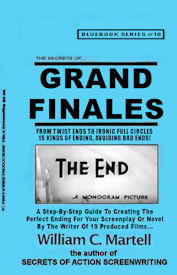
GRAND FINALES Blue Book!
The Perfect Ending For Your Story!
The First Ten Pages Of Your Screenplay Are Critical,
But What About The Last 10 Pages?
Creating the perfect ending to your story! This 100,000 word book shows you how to end your story with a bang, rather than a whimper. Everything from Resolution Order to Act Three Tools to Happy or Sad Endings? to How The Beginning Of Your Story Has Clues To The Ending (in case you were having trouble figuring out how the story should end) to Falling Action to How To Avoid Bad Endings to Writing The Perfect Twist Ending to Setting Up Sequels & Series to Emotional Resolutions to How To Write Post Credit Sequences to Avoiding Deus Ex Machinas, to 20 Different Types Of Ends (and how to write them) and much more! Everything about endings for your screenplay or novel!
Only$4.99
BRAND NEW
All About LOGLINES, TREATMENTS, and PITCHING!

LOGLINES, TREATMENTS, and PITCHING! Blue Book!
Distilling Your Screenplay!
Loglines, Treatments, Pitching, Look Books, Pitch Decks, One Pagers, Rip-O-Matics?
You have written a brilliant 110 page screenplay, but how do you get anyone to read it? You need to distill it down into some form of verbal moonshine or story rocket fuel that will ignite that bored development executive or manager or agent and get them to request your screenplay. But how do you shrink those 110 pages into a 25 word logline or a 2 minute elevator pitch or a one page synopsis or a short paragraph? This 100,000 word book shows you how! Everything you need to know! From common logline mistakes (and how to solve them) to how your pitch can reveal story problems to the 4 types of pitches!
272 pages - ONLY $4.99!
NEW: WRITE IT: FILM IT!

Making Your Own Movie?
Writing An Indie Film?
Writing A Low Budget Genre Script To Sell?
Writing A Made For TV Holiday Movie?
You will be writing for BUDGET. On a standard spec screenplay, you don’t have to think about budget, but these types of screenplays writing with budget in mind is critical!
If you are making your own movie, budget, is even more important - and you need to think about budget *before* you write your screenplay... or you will end up with a script that you can’t afford to make (or is a struggle to make). Everyone is making their own films these days, and even if you have done it before there are lots of great techniques in this book to get more money on screen - for less money! You can make a film that looks like it cost millions for pocket change.
344 pages - SALE:: $7.99!
NEW!

THE MISSION IMPOSSIBLE MOVIES
NEW: Updates On Films 7 & 8 Casting!
All Six Movies analyzed! All of the mission tapes, all of the “that’s impossible!” set pieces and stunts, the cons and capers - and how these scenes work, the twists and double crosses, the tension and suspense (and how to generate it), the concept of each film as a stand alone with a different director calling the shots (broken in the sixth film), the gadgets, the masks, the stories, the co-stars and team members (one team member has been in every film), the stunts Tom Cruise actually did (and the ones he didn’t), and so much more! Over 120,000 words of fun info!
THE MISSION IMPOSSIBLE MOVIES - 347 pages - Only $3.99 !
NO KINDLE REQUIRED! Get the *free* app (any device, except your Mr. Coffee) on the order page on Amazon!

BRAND NEW!
*** THE BOURNE MOVIES
All five "Bourne" movies (including "Legacy" and it's potential sequels) - what are the techniques used to keep the characters and scenes exciting and involving? Reinventing the thriller genre...
or following the "formula"? Five films - each with an interesting experiment! A detailed analysis of each
of the films, the way these thrillers work... as well as a complete list of box office and critical
statistics for each film. This book is great for writers, directors, and just fans of the series.
268 pages - Only $3.99
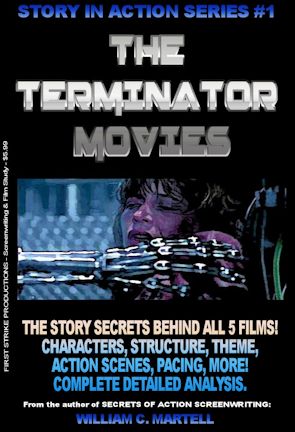
Over 240 pages!
*** THE TERMINATOR MOVIES *** - For Kindle!
He's back! The release of "Terminator: Dark Fate" is set to begin a new trilogy in
the Terminator story... 35 years after the first film was released. What draws us to these films about
a cybernetic organism from the future sent back in time? Why is there a new proposed trilogy every few
years? This book looks at all five Terminator movies from a story standpoint - what makes them work
(or not)? What are the techniques used to keep the characters and scenes exciting and involving? How
about those secret story details you may not have noticed? Containing a detailed analysis of each of
the five films so far, this book delves into the way these stories work... as well as a complete list of
box office and critical statistics for each film. This book is great for writers, directors, and just
fans of the series.
ONLY $3.99 - and no postage!
Tips FAQ

My New Script Secrets Newsletter!

NEW BOOKS!
BRAND NEW
OUTLINES & THE THEMATIC!
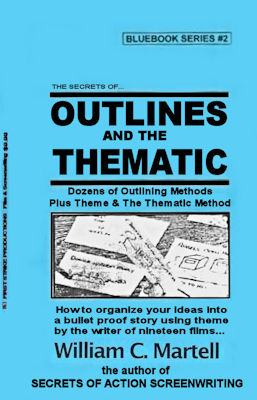
OUTLINES & THE THEMATIC Blue Book.
ARE YOUR SCENES IN THE RIGHT ORDER?
AND ARE THEY THE RIGHT SCENES?
Your story is like a road trip... but where are you going? What's the best route to get there? What are the best sights to see along the way? Just as you plan a vacation instead of just jump in the car and start driving, it's a good idea to plan your story. An artist does sketches before breaking out the oils, so why shouldn't a writer do the same? This Blue Book looks at various outlining methods used by professional screenwriters like Wesley Strick, Paul Schrader, John August, and others... as well as a guest chapter on novel outlines. Plus a whole section on the Thematic Method of generating scenes and characters and other elements that will be part of your outline. The three stages of writing are: Pre-writing, Writing, and Rewriting... this book looks at that first stage and how to use it to improve your screenplays and novels.
Only $4.99!
ALSO NEW!
DESCRIPTION & VOICE Blue Book!
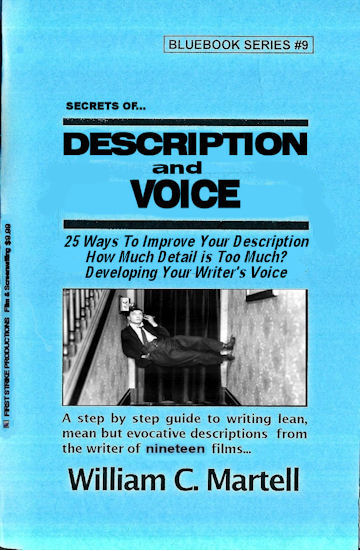
DESCRIPTION & VOICE Blue Book.
IS HALF OF YOUR STORY IN TROUBLE?
Most screenplays are about a 50/50 split between dialogue and description - which means your description is just as important as your dialogue. It just gets less press because the audience never sees it, the same reason why screenwriters get less press than movie stars. But your story will never get to the audience until readers and development executives read your script... so it is a very important factor. Until the movie is made the screenplay is the movie and must be just as exciting as the movie. So how do you make your screenplay exciting to read? Description is important in a novel as well, and the “audience” does read it... how do we write riveting description?
Only $4.99!
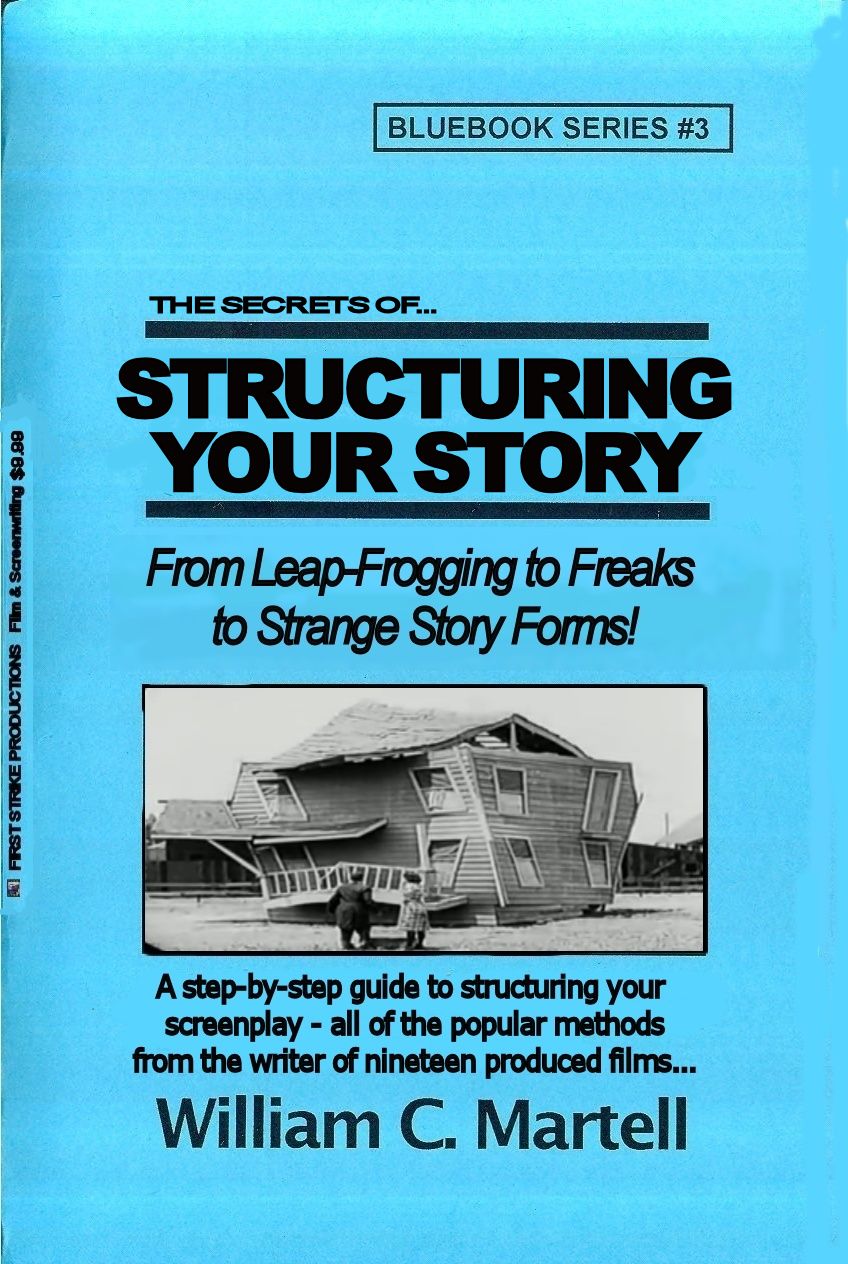
NEW AND HOT!
*** STRUCTURING YOUR STORY *** - For Kindle!
William Goldman says the most important single element of any screenplay is structure. It’s the skeleton under the flesh and blood of your story. Without it, you have a spineless, formless, mess... a slug! How do you make sure your structure is strong enough to support your story? How do you prevent your story from becoming a slug? This Blue Book explores different types of popular structures from the basic three act structure to more obscure methods like leap-frogging. We also look at structure as a verb as well as a noun, and techniques for structuring your story for maximum emotional impact. Most of the other books just look at *structure* and ignore the art of *structuring* your story. Techniques to make your story a page turner... instead of a slug!
Only $4.99 - and no postage!
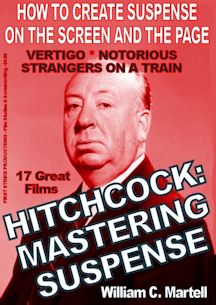
LEARN SUSPENSE FROM THE MASTER!
*** HITCHCOCK: MASTERING SUSPENSE *** - For Kindle!
Alfred Hitchcock, who directed 52 movies, was known as the *Master Of Suspense*; but what exactly is suspense and how can *we* master it? How does suspense work? How can *we* create “Hitchcockian” suspense scenes in our screenplays, novels, stories and films?
This book uses seventeen of Hitchcock’s films to show the difference between suspense and surprise, how to use “focus objects” to create suspense, the 20 iconic suspense scenes and situations, how plot twists work, using secrets for suspense, how to use Dread (the cousin of suspense) in horror stories, and dozens of other amazing storytelling lessons. From classics like “Strangers On A Train” and “The Birds” and “Vertigo” and “To Catch A Thief” to older films from the British period like “The 39 Steps” and “The Man Who Knew Too Much” to his hits from the silent era like “The Lodger” (about Jack The Ripper), we’ll look at all of the techniques to create suspense!
Only $5.99

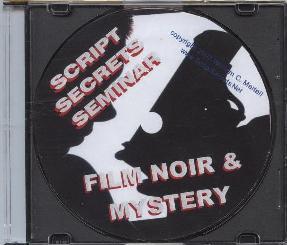
AUDIO CLASS!
NOIR & MYSTERY80 minute MP3 packed with information on writing Film Noir and Mystery scripts. Using examples from CHINATOWN to OUT OF THE PAST to DOUBLE INDEMNITY you'll learn how to create stories in this dark, twisted genre. How to plant clues, red herrings, suspects, victims, spider women, fallen heroes, the funhouse mirror world of noir supporting characters... and the origins of Film Noir in literature Noir dialogue and how noir endings are different than any other genre. All of the critical elements necessary to write in this critically popular genre.
The Noir & Mystery Class is only $15 (plus $5 S&H). First 20 on Limited Black Disk!
RECESSION SALE! $5 OFF!
IDEAS AND CREATIVITY - 80 minute MP3 packed with information. Tools to find ideas that are both personal *and* commercial. Hollywood wants scripts with High Concept stories... but not stupid scripts. Developing *intelligent* high concept ideas. How to turn your personal story into a blockbuster - or find your personal story in a high concept idea. Brainstorming and being creative. Ideas and Creativity is $10.00 (plus $5 S&H)
WRITING INDIES - Writing an Indie film? This class covers everything you need to know - from Central Locations to Confined Cameos. Using examples from SWINGERS, THE COOLER, STATION AGENT and others, this 80 minute MP3 is packed with information. How Indoe films challenge the audience (while mainstream films reassure the audience). Structures, using BOYS DON'T CRY, RUN LOLA RUN, HILARY & JACKIE, and others as example. Writing for a budget, writing for non-actors, getting the most production value out of your budget. Writing Indies is $10.00 (plus $5 S&H)
WRITING HORROR - The essentials of a horror screenplay - what do ROSEMARY'S BABY, NIGHT OF THE LIVING DEAD, THE EXORCIST, BRIDE OF FRANKENSTEIN, THE OTHERS and OPEN WATER have in common? This class will tell you! All of the critical elements necessary to write a script that scares the pants off the audience. Writing Horror is $10.00 (plus $5 S&H).
Click here for more information on CLASS MP3s!
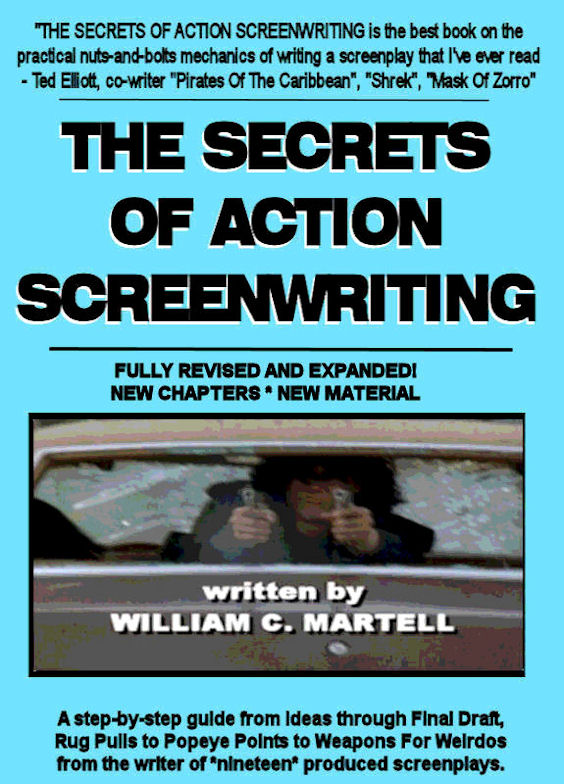
THE BOOK THAT STARTED IT ALL!
*** THE SECRETS OF ACTION SCREENWRITING *** - For Kindle!
*** THE SECRETS OF ACTION SCREENWRITING *** - For Nook!
Why pay $510 for a used version of the 240 page 2000 version that used to retail for $21.95? (check it out!) when
you can get the NEW EXPANDED VERSION - over 500 pages - for just $9.99? New chapters, New examples, New techniques!
"SECRETS OF ACTION SCREENWRITING is the
best book on the practical nuts-and-bolts mechanics of writing a screenplay I've ever read."
- Ted Elliott, co-writer of MASK OF ZORRO, SHREK, PIRATES OF THE CARIBBEAN and the sequels (with Terry Rossio). (ie; 4 of the top 20 Box Office Hits Of ALL TIME.)
Only $9.99 - and no postage!
READY TO BREAK IN?
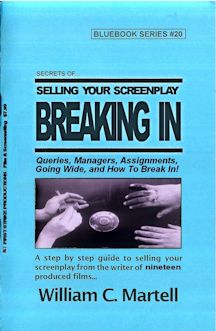
NEW!
*** BREAKING IN BLUE BOOK *** - For Kindle!
Should really be called the BUSINESS BLUE BOOK because it covers almost everything you will need to
know for your screenwriting career: from thinking like a producer and learning to speak their language,
to query letters and finding a manager or agent, to making connections (at home and in Hollywood) and
networking, to the different kinds of meetings you are will have at Studios, to the difference between
a producer and a studio, to landing an assignment at that meeting and what is required of you when you
are working under contract, to contracts and options and lawyers and... when to run from a deal!
Information you can use *now* to move your career forward! It's all here in the Biggest Blue Book yet!
Print version was 48 pages, Kindle version is over 400 pages!
$4.99 - and no postage!
NO KINDLE REQUIRED! Get the *free* app (any device, except your Mr. Coffee) on the order page on Amazon!
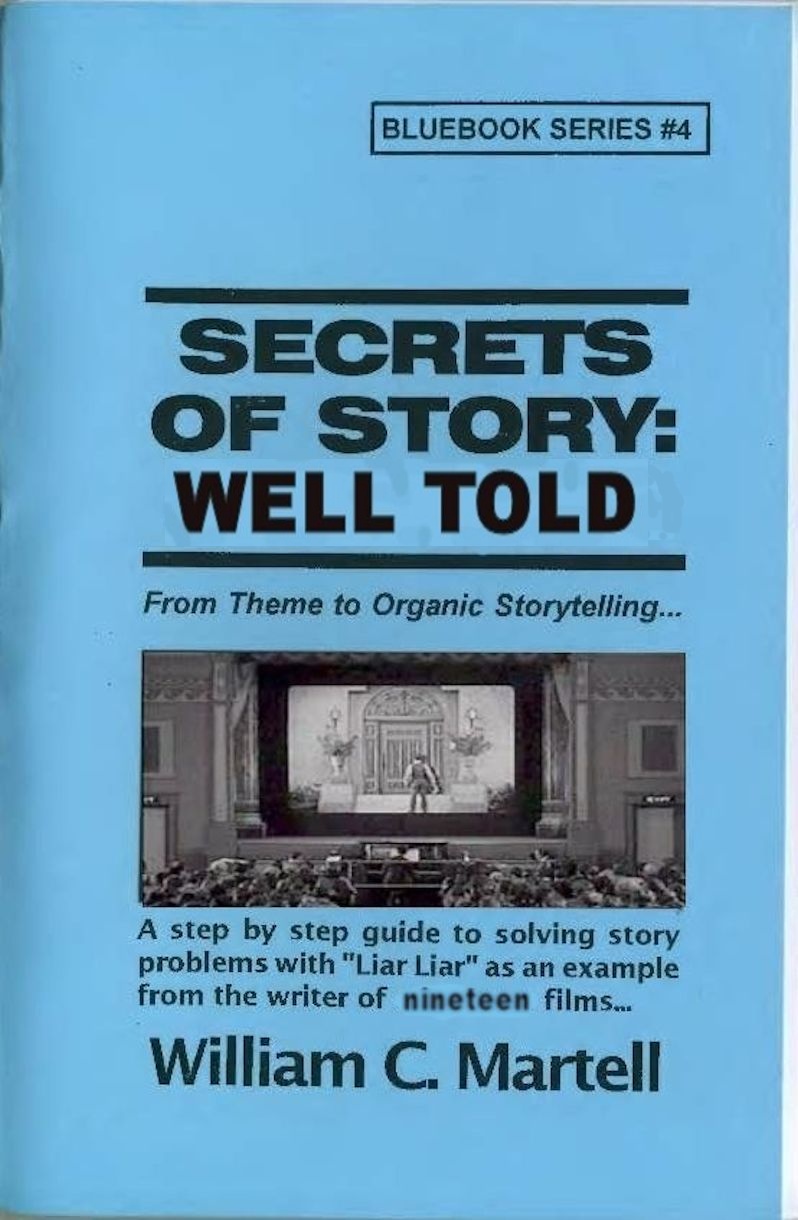
STORY: WELL TOLD!
*** STORY: WELL TOLD *** - For Kindle!
This book takes you step-by-step through the construction of a story... and how to tell a story well, why Story always starts with character... but ISN'T character, Breaking Your Story, Irony, Planting Information, Evolving Story, Leaving No Dramatic Stone Unturned, The Three Greek Unities, The Importance Of Stakes, The Thematic Method, and how to create personal stories with blockbuster potential. Ready to tell a story?
Print version was 48 pages, Kindle version is over 85,000 words - 251 pages!
Only $4.99 - and no postage!
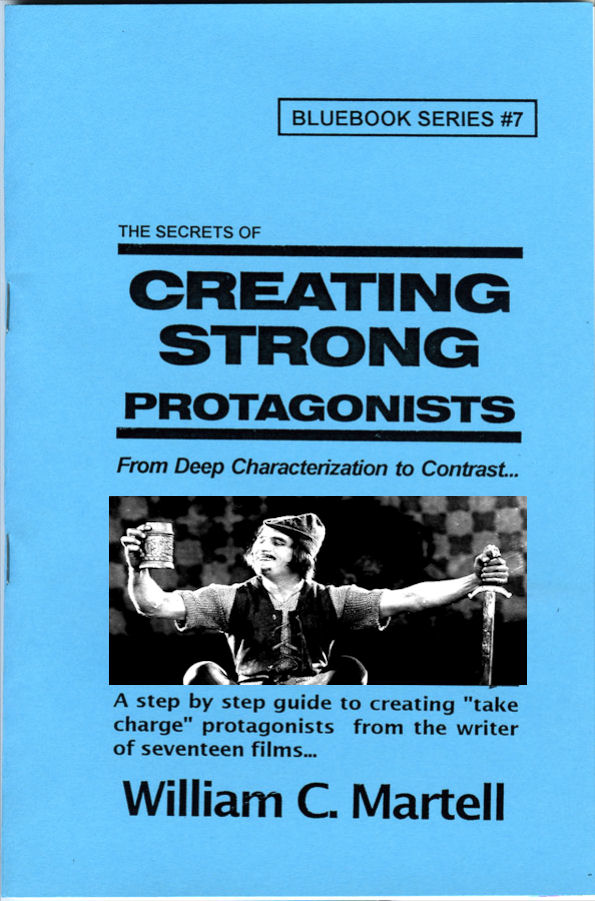
MOVIES ARE CHARACTERS!
*** CREATING STRONG PROTAGONISTS *** - For Kindle!
*** CREATING STRONG PROTAGONISTS *** - For Nook!
Expanded version with more ways to create interesting protagonists! A step-by-step guide to creating "take charge" protagonists. Screenplays are about characters in conflict... characters in emotional turmoil... Strong three dimensional protagonists who can find solutions to their problems in 110 pages. But how do you create characters like this? How do you turn words into flesh and blood? Character issues, Knowing Who Is The Boss, Tapping into YOUR fears, The Naked Character, Pulp Friction, Man With A Plan, Character Arcs, Avoiding Cliche People, Deep Characterization, Problem Protagonists, 12 Ways To Create Likable Protagonists (even if they are criminals), Active vs. Reactive, The Third Dimension In Character, Relationships, Ensemble Scripts, and much, much more. Print version is 48 pages, Kindle version is once again around 205 pages!
ONLY $4.99 - and no postage!
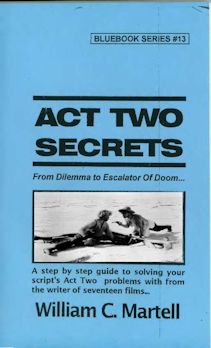
ACT TWO SOLUTIONS!
*** ACT TWO SECRETS *** - For Kindle!
Expanded version with more techniques to help you through the desert of Act Two! Subjects Include: What Is Act Two? Inside Moves, The 2 Ps: Purpose & Pacing, The 4Ds: Dilemma, Denial, Drama and Decision, Momentum, the Two Act Twos, Subplot Prisms, Deadlines, Drive, Levels Of Conflict, Escalation, When Act Two Begins and When Act Two Ends, Scene Order, Bite Sized Pieces, Common Act Two Issues, Plot Devices For Act Two, and dozens of others. Over 67,000 words (that’s well over 200 pages) of tools and techniques to get you through the desert of Act Two alive!
Print version was 48 pages, Kindle version is well over 200 pages!
ONLY $4.99 - and no postage!
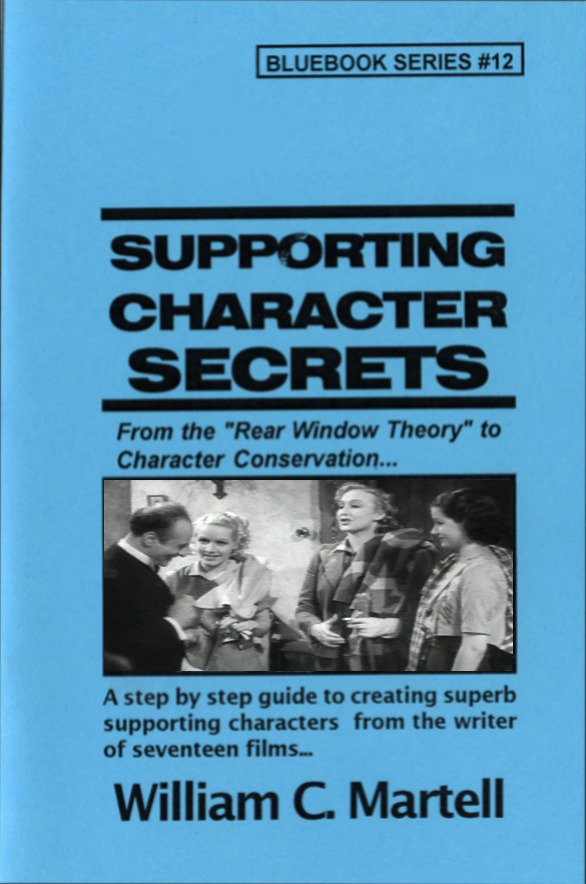
SUBPLOTS?
*** SUPPORTING CHARACTER SECRETS *** - For Kindle! (Exclusive)
Expanded version with more techniques to flesh out your Supporting Characters and make them individuals. Using the hit movie BRIDESMAIDS as well as other comedies like THE HANGOVER and TED and HIGH FIDELITY and
40 YEAR OLD VIRGIN and many other examples we look at ways to make your Supporting Characters come alive on the page.
Print version was 48 pages, Kindle version is around 170 pages!
ONLY $4.99 - and no postage!

ADVICE FROM 1920!
*** VINTAGE #1: HOW TO WRITE PHOTOPLAYS *** - For Kindle!
***
Screenwriting books have been around as long as films have. This series reprints vintage screenwriting books with a new introduction and history, plus new articles which look at how these lessons from almost 100 years ago apply to today’s screenplays. Anita Loos book is filled with information which still applies.
In addition to the full text of the original book, you get the full screenplay to Miss Loos' hit THE LOVE EXPERT, plus several new articles on the time period and women in Hollywood.
ONLY $2.99 - and no postage!
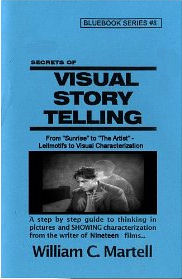
I WRITE PICTURES!
*** VISUAL STORYTELLING *** - For Kindle! (exclusive)
Show Don't Tell - but *how* do you do that? Here are techniques to tell stories visually! Using Oscar Winning Films and Oscar Nominated Films as our primary examples: from the first Best Picture Winner "Sunrise" (1927) to the Oscar Nominated "The Artist" (which takes place in 1927) with stops along the way Pixar's "Up" and Best Original Screenplay Winner "Breaking Away" (a small indie style drama - told visually) as well as "Witness" and other Oscar Winners as examples... plus RISE OF THE PLANET OF THE APES. Print version is 48 pages, Kindle version is over 200 pages!
ONLY $4.99 - and no postage!
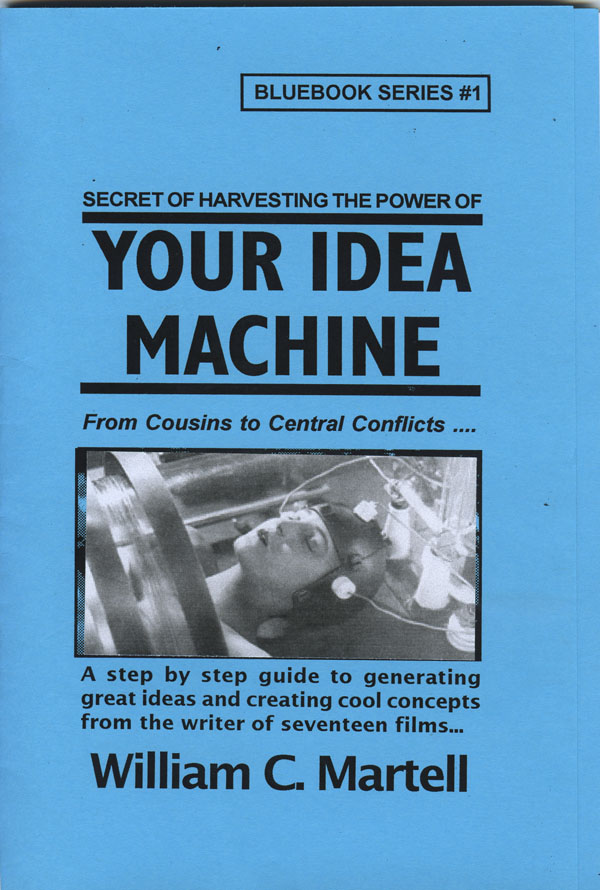
BEST SELLER!
*** YOUR IDEA MACHINE *** - For Kindle!
*** YOUR IDEA MACHINE *** - For Nook!
Expanded version with more ways to find great ideas! Your screenplay is going to begin with an idea. There are good ideas and bad ideas and commercial ideas and personal ideas. But where do you find ideas in the first place? This handbook explores different methods for finding or generating ideas, and combining those ideas into concepts that sell. The Idea Bank, Fifteen Places To Find Ideas, Good Ideas And Bad Ideas, Ideas From Locations And Elements, Keeping Track Of Your Ideas, Idea Theft - What Can You Do? Weird Ways To Connect Ideas, Combing Ideas To Create Concepts, High Concepts - What Are They? Creating The Killer Concept, Substitution - Lion Tamers & Hitmen, Creating Blockbuster Concepts, Magnification And The Matrix, Conflict Within Concept, Concepts With Visual Conflict, Avoiding Episodic Concepts, much more! Print version is 48 pages, Kindle version is over 175 pages!
Only $4.99 - and no postage!
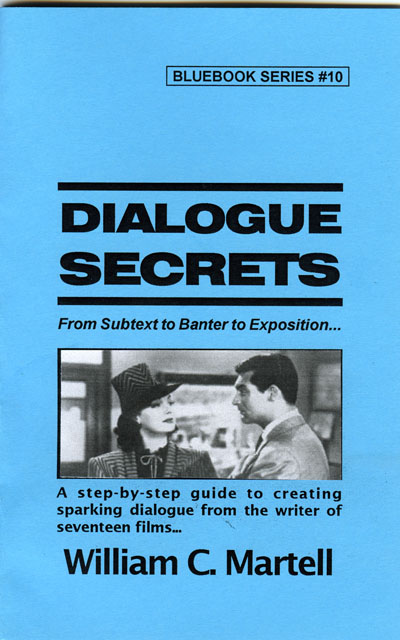
PRO DIALOGUE TECHNIQUES!
*** DIALOGUE SECRETS *** - For Kindle!
*** DIALOGUE SECRETS *** - For Nook!
Expanded version with more ways to create interesting dialogue! How to remove bad dialogue (and what *is* bad dialogue), First Hand Dialogue, Awful Exposition, Realism, 50 Professional Dialogue Techniques you can use *today*, Subtext, Subtitles, Humor, Sizzling Banter, *Anti-Dialogue*, Speeches, and more. Tools you can use to make your dialogue sizzle! Special sections that use dialogue examples from movies as diverse as "Bringing Up Baby", "Psycho", "Double Indemnity", "Notorious", the Oscar nominated "You Can Count On Me", "His Girl Friday", and many more! Print version is 48 pages, Kindle version is over 175 pages!
Only $4.99 - and no postage!

Use your creative energy to focus on the content; let Final Draft take care of the style. Final Draft is the number-one selling application specifically designed for writing movie scripts, television episodics and stage plays. Its ease-of-use and time-saving features have attracted writers for almost two decades positioning Final Draft as the Professional Screenwriters Choice. Final Draft power users include Academy, Emmy and BAFTA award winning writers like Oliver Stone, Tom Hanks, Alan Ball, J.J. Abrams, James Cameron and more.
* * * Buy It!

|
|
|
|
|
E BOOKS PAGE
|
|
 E BOOKS: New Blue Books and Novelettes!
E BOOKS: New Blue Books and Novelettes!
I am expanding all of the Blue Books from around 44 pages of
text to around 200 pages! Some are over 250 pages! See what is availabale and what is coming soon!Also, I've been writing Novelletes and there
will soon be novels.
E BOOKS: BLUE BOOKS & NOVELLETES
|
|
ONLINE CLASSES
|
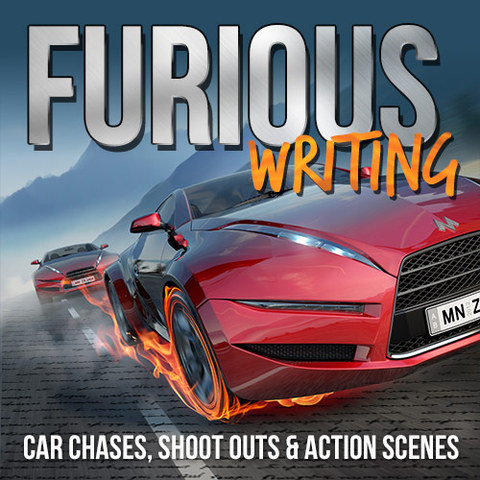
|
|
MY OTHER SITES
|
|
B MOVIE WORLD
Cult Films, Exploitation, Bikers & Women In Prison, Monster Movies.
FIRST STRIKE PRODUCTIONS
Producing my own scripts, investment possibilities, pipe dreams.
|
|
NAKED SCREENWRITING MP3s
|
|
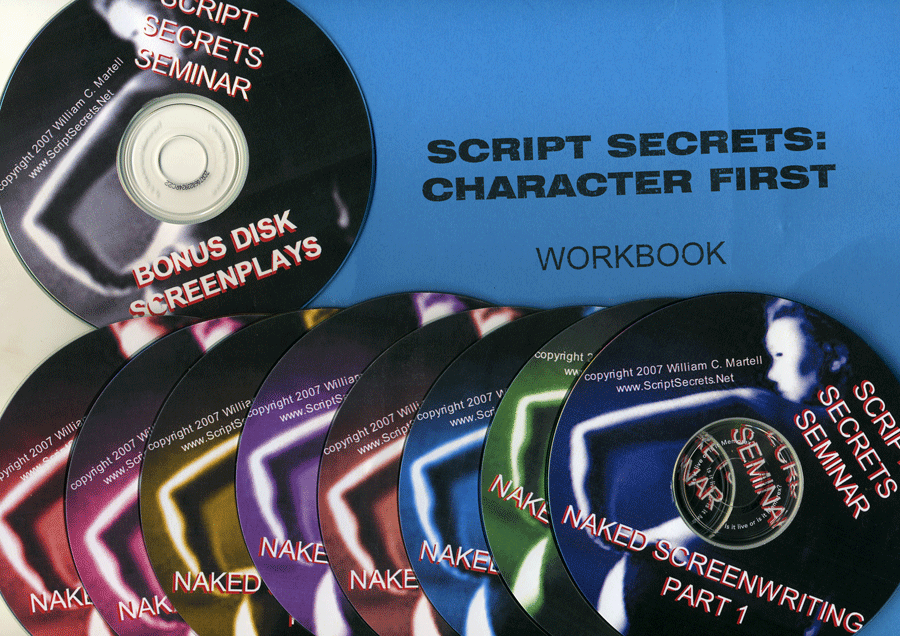 The NAKED SCREENWRITING CLASS ON MP3!
The 2001 London Class on 8 MP3s! Recorded *live* the morning after the Raindance Film Festival
wrapped. The two day class on 8MP3s, plus a workbook, plus a bonus MP3 with PDFs.
The NAKED SCREENWRITING CLASS ON MP3!
The 2001 London Class on 8 MP3s! Recorded *live* the morning after the Raindance Film Festival
wrapped. The two day class on 8MP3s, plus a workbook, plus a bonus MP3 with PDFs.
The 2 Day Class on MP3!
|
|
BOOKSTORE
|
|
Every screenwriting book in the world!
SCREENWRITER'S BOOKSTORE
In Association With Amazon.com
From the latest screenwriting book to
guides for finding agents and producers... all with at the
Amazon.com discount!
|
|
BOOKLETS & PRODUCTS
|
|
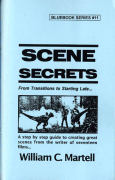 FIRST STRIKE BLUE BOOKS
FIRST STRIKE BLUE BOOKS
Each Blue Book is 48
pages and focuses on a different aspect of screenwriting. Dialogue. Visual Storytelling. Your First Ten Pages. Act 2 Booster. Protagonists. Great Endings.
Seventeen Blue Books now available!
THE SECRETS OF ACTION SCREENWRITING The Best Nuts & Bolts Screenwriting Book On The
Market!
|
|
BILL'S CORNER
|
|
My
nineteen produced films, interviews with me in magazines,
several sample scripts, my available scripts list... And MORE!
...............................BILL'S CORNER
Available Scripts
|
|
CLASSES ON MP3
|
|
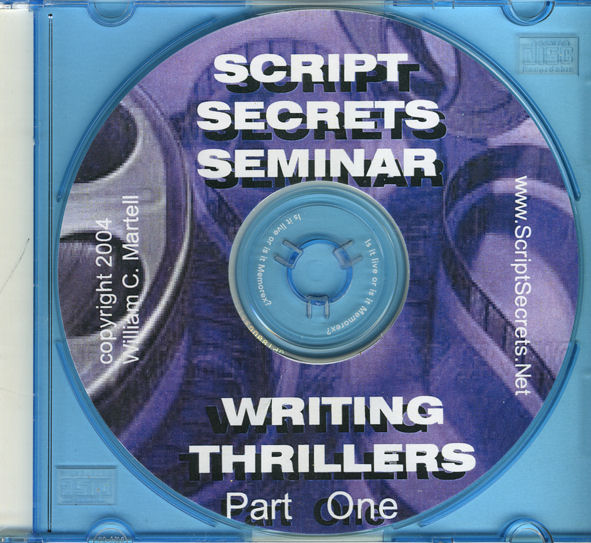 CLASSES ON MP3! Take a class on MP3! GUERRILLA MARKETING - NO AGENT? NO PROBLEM! and WRITING THRILLERS (2 Full length classes on MP3). Now Available: IDEAS & CREATIVITY, WRITING HORROR, WRITING INDIE FILMS, more!
CLASSES ON MP3! Take a class on MP3! GUERRILLA MARKETING - NO AGENT? NO PROBLEM! and WRITING THRILLERS (2 Full length classes on MP3). Now Available: IDEAS & CREATIVITY, WRITING HORROR, WRITING INDIE FILMS, more!
Take classes on MP3!
|
|
|
|
|

